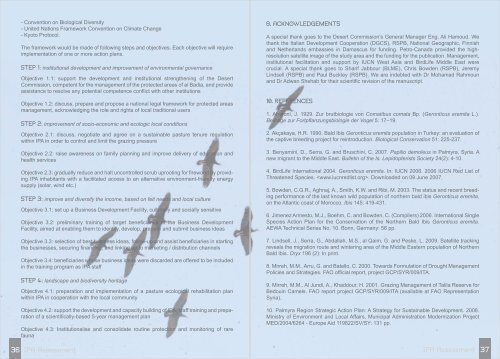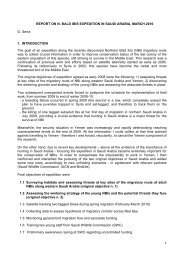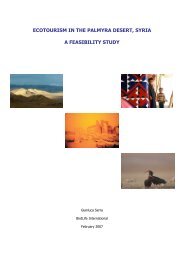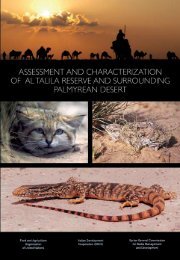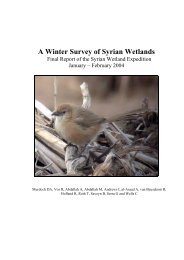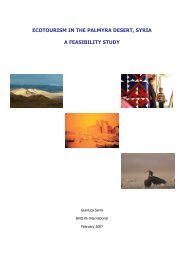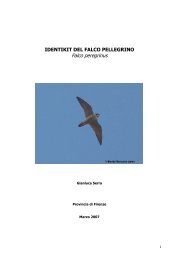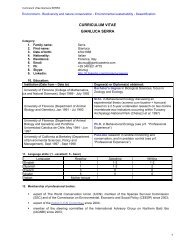final cover - home page
final cover - home page
final cover - home page
Create successful ePaper yourself
Turn your PDF publications into a flip-book with our unique Google optimized e-Paper software.
- Convention on Biological Diversity<br />
- United Nations Framework Convention on Climate Change<br />
- Kyoto Protocol.<br />
The framework would be made of following steps and objectives. Each objective will require<br />
implementation of one or more action plans.<br />
STEP 1: institutional development and improvement of environmental governance<br />
Objective 1.1: support the development and institutional strengthening of the Desert<br />
Commission, competent for the management of the protected areas of al Badia, and provide<br />
assistance to resolve any potential competence conflict with other institutions<br />
Objective 1.2: discuss, prepare and propose a national legal framework for protected areas<br />
management, acknowledging the role and rights of local traditional users<br />
STEP 2: improvement of socio-economic and ecologic local conditions<br />
Objective 2.1: discuss, negotiate and agree on a sustainable pasture tenure regulation<br />
within IPA in order to control and limit the grazing pressure<br />
Objective 2.2: raise awareness on family planning and improve delivery of education and<br />
health services<br />
Objective 2.3: gradually reduce and halt uncontrolled scrub uprooting for firewood by providing<br />
IPA inhabitants with a facilitated access to an alternative environment-friendly energy<br />
supply (solar, wind etc.)<br />
STEP 3: improve and diversify the income, based on felt needs and local culture<br />
Objective 3.1: set up a Business Development Facility, culturally and socially sensitive<br />
Objective 3.2: preliminary training of target beneficiaries at the Business Development<br />
Facility, aimed at enabling them to identify, develop, prepare and submit business ideas<br />
Objective 3.3: selection of best business ideas, follow-up and assist beneficiaries in starting<br />
the businesses, securing financing, and linking up to marketing / distribution channels<br />
Objective 3.4: beneficiaries whose business ideas were discarded are offered to be included<br />
in the training program as IPA staff<br />
STEP 4: landscape and biodiversity heritage<br />
Objective 4.1: preparation and implementation of a pasture ecological rehabilitation plan<br />
within IPA in cooperation with the local community<br />
Objective 4.2: support the development and capacity building of IPA: staff training and preparation<br />
of a scientifically-based 5-year management plan<br />
Objective 4.3: Institutionalise and consolidate routine protection and monitoring of rare<br />
fauna<br />
9. ACKNOWLEDGEMENTS<br />
A special thank goes to the Desert Commission’s General Manager Eng. Ali Hamoud. We<br />
thank the Italian Development Cooperation (DGCS), RSPB, National Geographic, Finnish<br />
and Netherlands embassies in Damascus for funding. Petro-Canada provided the highresolution<br />
satellite image of the study area and the funding for the publication. Management,<br />
institutional facilitation and support by IUCN West Asia and BirdLife Middle East were<br />
crucial. A special thank goes to Sharif Jabbour (BLME), Chris Bowden (RSPB), Jeremy<br />
Lindsell (RSPB) and Paul Buckley (RSPB). We are indebted with Dr Mohamad Rahmoun<br />
and Dr Adwan Shehab for their scientific revision of the manuscript.<br />
10. REFERENCES<br />
1. Aharoni, J. 1929. Zur brutbiologie von Comatibus comata Bp. (Geronticus eremita L.).<br />
Beitrage zur Fortpflanzungsbiologie der Vogel 5: 17–19.<br />
2. Akçakaya, H.R. 1990. Bald Ibis Geronticus eremita population in Turkey: an evaluation of<br />
the captive breeding project for reintroduction. Biological Conservation 51: 225-237.<br />
3. Benyamini, D., Serra, G. and Bruschini, C. 2007. Papilio demoleus in Palmyra, Syria. A<br />
new migrant to the Middle East. Bulletin of the Is. Lepidopterists Society 24(2): 4-10.<br />
4. BirdLife International 2004. Geronticus eremita. In: IUCN 2006. 2006 IUCN Red List of<br />
Threatened Species. . Downloaded on 09 June 2007.<br />
5. Bowden, C.G.R., Aghnaj, A., Smith, K.W. and Ribi, M. 2003. The status and recent breeding<br />
performance of the last known wild population of northern bald ibis Geronticus eremita,<br />
on the Atlantic coast of Morocco. Ibis 145: 419-431.<br />
6. Jimenez Armesto, M.J., Boehm, C. and Bowden, C. (Compilers) 2006. International Single<br />
Species Action Plan for the Conservation of the Northern Bald Ibis Geronticus eremita.<br />
AEWA Technical Series No. 10. Bonn, Germany: 56 pp.<br />
7. Lindsell, J., Serra, G., Abdallah, M.S., al Qaim, G. and Peske, L. 2009. Satellite tracking<br />
reveals the migration route and wintering area of the Middle Eastern population of Northern<br />
Bald Ibis. Oryx 196 (2): In print.<br />
8. Mirreh, M.M., Arru, G. and Batello, C. 2000. Towards Formulation of Drought Management<br />
Policies and Strategies. FAO official report, project GCP/SYR/009/ITA.<br />
9. Mirreh, M.M., Al Jundi, A., Khaddour, H. 2001. Grazing Management of Talila Reserve for<br />
Bedouin Camels. FAO report project GCP/SYR/009/ITA (available at FAO Representation<br />
Syria).<br />
10. Palmyra Region Strategic Action Plan: A Strategy for Sustainable Development. 2008.<br />
Ministry of Environment and Local Affairs, Municipal Administration Modernization Project<br />
MED/2004/6264 - Europe Aid 119822/SV/SY: 131 pp.<br />
36 IPA Assessment IPA Assessment 37


